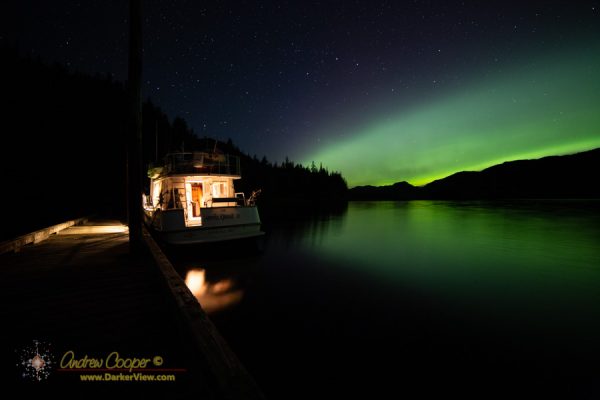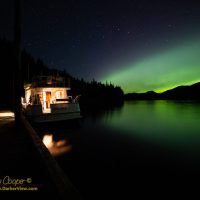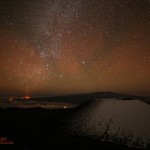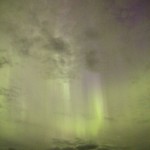
Category: Aurora
Aurora Timelapse
We got lucky. When it happened we were well positioned to view, and photograph the show.

Even better, that night we were moored to a state float rather than simply sitting at anchor, or even worse, docked in a town or city. In Helm Bay, 22 miles north of Ketchikan, we had a beautiful dark sky and a perfect setting to watch the show.
With a float I had a stable platform from which to shoot time lapse video, no rocking or swinging at anchor. I could set up the camera and tripod and let the intervalometer click away for over an hour.
The video is made from 360 separate exposures compiled into a video about 30 seconds long. Each frame was 10 seconds at ISO6400 using a Canon 6D camera and a Rokinon 14mm f/2.8 lens set to f/3.2. The frames are projected at 12 frames per second in the version below.
The ten second frames are still too long, the glowing bands of light move quite quickly, at times rippling across the sky. The result is that the patterns and motion in the aurora is blurred.
The aurora was quite bright, my usual 15 second night sky shots actually overexposing. I dialed back the exposure a bit, and should probably have dialed it back a bit more.
Aurora
When traveling in Alaska I regularly check the weather forecast. Not just the marine forecast, but the space weather forecast.

Space weather? Yes, our planet has weather out in space, weather created by streams of charged particles from our star. Sun spots, solar flares, and coronal holes can all cause these emissions to intensify. When these particles impact the magnetic field around the Earth it can create a geomagnetic storm.
Aurora at Helm Bay
Geomagnetic Activity and Airglow
Taking starscape photos last week I was surprised at the intense red glow appearing in the photographs. All across the southern sky were glowing areas of sky, here and there dark rifts cut through the glow. Set beside the Winter Milky Way it created beautiful photographs.

The airglow was intense enough to be visually seen when I stepped away from the camera and let my eyes adapt to the darkness. Away from the Milky Way, in what should be dark sky, a faint red glow pervaded. I wondered what was going on, the normal airglow over Mauna Kea is quite faint and usually very green.
I was even further surprised when I later found out that a strong geomagnetic storm was in progress that night. Kp=6 conditions from back to back CME’s were creating strong aurora over Canada and the upper US.
Was I seeing some sort of auroral glow? In Hawaii? At 20°N latitude? This did not seem likely, but something unusual was occurring!
Staying Late at Work
The plan was simple. Stay on the summit after work to do some nighttime scenic photography.
I was hesitant in going up after suffering my recent ear infection. The ear is vastly better, no problems with clearing the ear for several days. After two weeks absence the list of things I needed to get done on the summit was getting lengthy and urgent. Yet I worried a bit about going up. An idea… Take my own vehicle. If I have trouble I can go at my own pace without holding up the rest of the guys. If the trouble is serious I can abort and head back down.
If I did bring my own vehicle I could get in a little photography along the way. I had not really had a chance to try out the Rokinon 14mm f/2.8 lens I had bought specifically for starry sky work. Why not stay late, watch sunset and take a few photos after dark? There is snow on the summit, the weather looked promising, the Moon would not rise until after 10pm, all good things.
The plan worked as envisioned. A good day getting stuff done. Actually a rather hectic day. The filter wheel problem of TRICK found and eliminated, the heater circuit at least looked at, I think the problem is still there. Warping data recorded for a segment in Keck 2 for the refurbishment project. Some wiring on TBAD completed, still more to do. An issue with the Keck 2 interlocks that popped up during the day was dealt with. Yes, a very good day.
A minimal dinner of instant ramen, and some paperwork accomplished while waiting for sunset.
Into the cold dark I go… The combination of the Canon 6D and the fast 14mm lens is impressive. This gear will really allow me to step up my game. I was able to shoot great material under very dark conditions. Photos that had been just out of reach for me until now. It will take me a couple days to go through and process the material, but a first look is very pleasing.
Only one problem… What is this red stuff showing up in my photos? Normal airglow is green, but this is crimson red and has very distinct structure? The idea of aurora crosses my mind, almost immediately dismissed as I am standing at 20°N latitude. I step away from the camera and the light for a bit. With some effort I can convince myself that I am seeing red in the sky, at least in the darker areas away from the Milky Way. But it is fleeting, and perhaps just an overactive desire to see something.
I get home and just out of curiosity I check the planetary Kp index… What?!? We have a Kp=6 geomagnetic storm in progress! Beautiful aurora photos are being posted from the upper midwest. Reports of aurora from across much of the United States. There is certainly a dramatic storm in progress. Perhaps this is a low latitude auroral glow!
There are some references to auroral glows detected at all latitudes during strong geomagnetic storms. Is this what my camera is detecting?
It is a nice photo. You can see the glow from the lava lake at Halemaʻumaʻu, the winter Milky Way, and a research laser shining straight up from the atmospheric lab atop Mauna Loa.

Tracking the Aurora Borealis
As our Sun continues through the current solar maximum we should have plenty of opportunities to view one of the most sublime of all natural spectacles, the Aurora Borealis.

Solar Activity
Solar activity waxes and wanes in an eleven year cycle. When active there are increased numbers of sunspots and solar flares. It is this activity that can have such a dramatic effect here on Earth. A strong solar flare can be accompanied by a release of enormous quantities of material from the Sun. Called a coronal mass ejection (CME) this material streams outwards from the Sun. If the Earth happens to be in the path this material will strike the Earth’s magnetic field, causing the field to distort and reverberate with the impact. Charged particles are channeled into the atmosphere along the magnetic field to create a glowing spectacle.
Our current solar maximum should run through 2013 and into 2014 providing excellent auroral viewing conditions for the next year or two.
Aurora Borealis
This trip to Alaska offered an opportunity that I had not experienced on previous trips due to the confluence of two conditions… I would be visiting later in the year than usual, it would actually get properly dark. When visiting Southeast Alaska in June and July the amount of darkness is dramatically limited by long summer days. The second condition is even less easily arranged… Our Sun is near the peak of its eleven year solar cycle. This results in more solar activity including large sunspots and energetic solar flares.
Put the two of these factors together and there is a good possibility of seeing the Aurora Borealis.
It is only a possibility, not a certainty by any measure… This was not a trip to the far north, where the auroral circle usual sits. If one were to travel north of Fairbanks into the true arctic one is almost guaranteed to see the aurora during solar max. I would be traveling between Juneau and Anacortes, from 58 to 48 degrees north latitude. At these latitudes it would take a strong geomagnetic storm to bring the aurora south into view. The chances of such a strong storm were relatively good, we are currently experiencing an active Sun near solar maximum, averaging a decent storm every month or two. In any case the odds were a bit better than seeing the aurora at home in Hawai’i.
At least there would be no light pollution to deal with, significant outposts of civilization are sparse along the route we would be traveling. One complication would be weather… Of the twenty days I would spend in northerly latitudes, about half were clouded over, thus the odds of seeing a good auroral display were modest, maybe even unlikely.
We got lucky.
